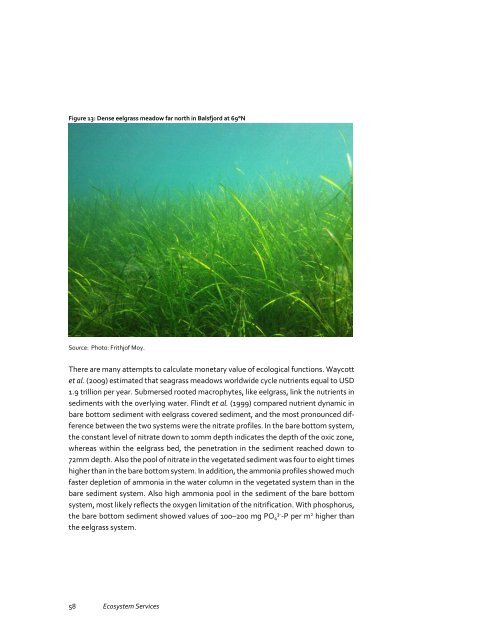Ecosystem Services
FULLTEXT01
FULLTEXT01
You also want an ePaper? Increase the reach of your titles
YUMPU automatically turns print PDFs into web optimized ePapers that Google loves.
Figure 13: Dense eelgrass meadow far north in Balsfjord at 69°N<br />
Source: Photo: Frithjof Moy.<br />
There are many attempts to calculate monetary value of ecological functions. Waycott<br />
et al. (2009) estimated that seagrass meadows worldwide cycle nutrients equal to USD<br />
1.9 trillion per year. Submersed rooted macrophytes, like eelgrass, link the nutrients in<br />
sediments with the overlying water. Flindt et al. (1999) compared nutrient dynamic in<br />
bare bottom sediment with eelgrass covered sediment, and the most pronounced difference<br />
between the two systems were the nitrate profiles. In the bare bottom system,<br />
the constant level of nitrate down to 10mm depth indicates the depth of the oxic zone,<br />
whereas within the eelgrass bed, the penetration in the sediment reached down to<br />
72mm depth. Also the pool of nitrate in the vegetated sediment was four to eight times<br />
higher than in the bare bottom system. In addition, the ammonia profiles showed much<br />
faster depletion of ammonia in the water column in the vegetated system than in the<br />
bare sediment system. Also high ammonia pool in the sediment of the bare bottom<br />
system, most likely reflects the oxygen limitation of the nitrification. With phosphorus,<br />
the bare bottom sediment showed values of 100–200 mg PO 4<br />
3-<br />
-P per m 2 higher than<br />
the eelgrass system.<br />
58 <strong>Ecosystem</strong> <strong>Services</strong>


